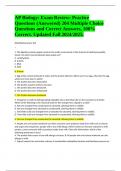-
1. Exam (elaborations) - Ap bio penguins unit 1 tbc exam 2023 with complete solution
-
2. Exam (elaborations) - Ap bio penguins unit 1 tbc exam 2023 with complete solution
-
3. Exam (elaborations) - Ap biology exam question and answers verified 100% a+ 2024, with rationale.
-
4. Exam (elaborations) - Ap biology questions and answers (graded a)
-
5. Exam (elaborations) - Ap biology questions and answers (graded a)
-
6. Exam (elaborations) - Ap biology questions and answers (graded a)
-
7. Exam (elaborations) - Ap biology [practice ap exam] questions and answers (graded a)
-
8. Exam (elaborations) - Ap biology [practice ap exam] questions and answers (graded a)
-
9. Exam (elaborations) - People to know - ap biology exam questions and answers
-
10. Exam (elaborations) - Ap bio mock exam questions and answers 2024
-
11. Exam (elaborations) - Ap bio-exam 2 questions and answers
-
12. Exam (elaborations) - Ap biology entrance exam with correct answers
-
13. Exam (elaborations) - Ap biology practice exam
-
14. Exam (elaborations) - Ap biology exam #3
-
15. Exam (elaborations) - Ap biology exam 2021|complete questions with a+ graded answers |updated 20242025
-
16. Exam (elaborations) - Ap biology exam frq's (unit 1)
-
17. Exam (elaborations) - Ap biology midterm exam study guide
-
18. Exam (elaborations) - Ap biology exam book questions and answers
-
19. Exam (elaborations) - Ap biology midterm exam
-
20. Exam (elaborations) - Ap biology exam college board questions and answers
-
21. Exam (elaborations) - Ap biology exam cram study guide 2024
-
22. Exam (elaborations) - Ap biology exam key words questions and answers
-
23. Exam (elaborations) - Ap biology exam questions and answers graded a+
-
24. Exam (elaborations) - Ap biology exam questions and answers graded a+
-
25. Exam (elaborations) - Ap biology exam review (vocab) questions and answers
-
26. Exam (elaborations) - Ap biology exam review chapters 1-9 questions and answers
-
27. Exam (elaborations) - Ap biology exam review guide chapter 1-15 questions and answers
-
28. Exam (elaborations) - Ap biology exam review practice questions and answers
-
29. Exam (elaborations) - Ap biology exam review questions and answers
-
30. Exam (elaborations) - Ap biology exam review questions and answers
-
31. Exam (elaborations) - Ap biology full exam review|a+ graded
-
32. Exam (elaborations) - Ap biology 1 questions and answers
-
33. Exam (elaborations) - Ap biology exam review unit 1 questions and answers
-
34. Exam (elaborations) - Ap biology exam study guide and tips questions and answers
-
35. Exam (elaborations) - Ap biology exam terms questions and answers
-
36. Exam (elaborations) - Ap biology exam ultimate study guide graded a+
-
37. Exam (elaborations) - Ap biology|complete questions with a+ graded answers
-
38. Exam (elaborations) - Ap biology exam terms
-
39. Exam (elaborations) - Ap biology final exam practice test-answered
-
40. Exam (elaborations) - Ap biology final exam review 2024 questions and answers
-
41. Exam (elaborations) - Ap biology multiple choice exam questions and answers
-
42. Exam (elaborations) - Ap biology practice exam questions and answers
-
43. Exam (elaborations) - Ap biology semester 1 review
-
44. Exam (elaborations) - Ap biology study guide latest updated
-
45. Exam (elaborations) - Ap biology test 1 questions and answers
-
46. Exam (elaborations) - Ap biology unit 1 test 100% solved
-
47. Exam (elaborations) - Ap biology unit 1.5 ap exam review questions and answers
-
48. Exam (elaborations) - Ap biology unit 2 cell structure exam review questions and answers
-
49. Exam (elaborations) - Ap biology unit 2.1 ap exam review questions and answers
-
50. Exam (elaborations) - Chapters 1-12 ap biology exam complete questions and answers
-
51. Exam (elaborations) - Pre-ap biology final exam with complete solutions
-
52. Exam (elaborations) - Ultimate ap biology exam review questions and answers graded a+
-
53. Exam (elaborations) - Ap biology final exam review. fall 2024/2025. 100% correct. 74 q&a.
-
54. Exam (elaborations) - Ap biology semester 1 review (answered) 156 q&a, latest fall 2024/2025. 100% correct.
-
55. Exam (elaborations) - Ap bio: ecology review (answered) 96 questions and correct answers, 100% correct. lat...
-
56. Exam (elaborations) - 2024 ap biology final exam (answered) 67 questions and correct answers, 100% correct....
-
57. Exam (elaborations) - Ap biology unit 1 test (answered) 86 questions and correct answers, 100% correct. upd...
-
58. Exam (elaborations) - (combined) ap biology unit 1, ap biology unit 2 (answered) 201 questions and correct ...
-
59. Exam (elaborations) - Ap biology biochemistry exam (answered) 106 questions and correct answers. fall 2024/...
-
60. Exam (elaborations) - Ap biology midterm exam (answered) 180 questions and correct answers, 100% correct. u...
-
61. Exam (elaborations) - Ap biology midterm review (answered) 100% correct. 2024/2025.
-
62. Exam (elaborations) - Ap biology exam (units 5-8), 100% correct, updated fall 2024/2025.
-
63. Exam (elaborations) - Ap biology final exam review (answered) 224 questions and correct answers, updated fa...
-
64. Exam (elaborations) - Ap biology: exam review: practice questions (answered) 204 multiple choice questions ...
-
65. Exam (elaborations) - Ap biology exam review 2024/2025. 288 questions and correct answers, 100% verified.
-
Show more




